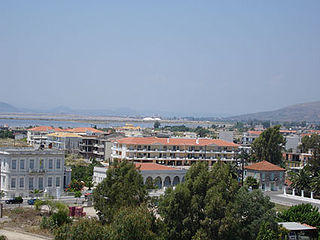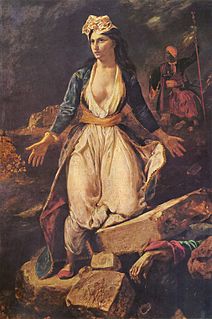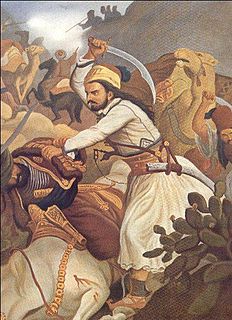
Missolonghi or Messolonghi is a municipality of 34,416 people in western Greece. The town is the capital of Aetolia-Acarnania regional unit, and the seat of the municipality of Iera Polis Messolongiou. Missolonghi is known as the site of a dramatic siege during the Greek War of Independence, and of the death of poet Lord Byron.

Grigorios Dimitriou Dikaios-Flessas, popularly known as Papaflessas was a Greek priest and government official who became one of the most influential figures during the Greek War of Independence. The prefix papa- (παπα-) in the name "Papaflessas" indicates his status as a cleric since the word means "priest" in Greek. He was appointed Archimandrite in 1819. He served as Minister of Internal Affairs and Chief of Police in the government of Alexander Mavrocordatos. Papaflessas was killed during the Battle of Maniaki on May 20, 1825, fighting against the forces of Ibrahim Pasha at Maniaki, Messinia.

The Battle of Phaleron, or "Battle of Analatos", took place on April 24, 1827. The Greek rebel forces were being besieged inside the Acropolis of Athens by Ottoman forces under the command of Mehmed Reshid Pasha. Greek forces outside the city were desperately trying to break the siege.

The Third Siege of Missolonghi was fought in the Greek War of Independence, between the Ottoman Empire and the Greek rebels, from 15 April 1825 to 10 April 1826. The Ottomans had already tried and failed to capture the city in 1822 and 1823, but returned in 1825 with a stronger force of infantry and a stronger navy supporting the infantry. The Greeks held out for almost a year before they ran out of food and attempted a mass breakout, which however resulted in a disaster, with the larger part of the Greeks slain. This defeat was a key factor leading to intervention by the Great Powers who, hearing about the atrocities, felt sympathetic to the Greek cause.

Georgios Karaiskakis, born Georgios Karaiskos, was a famous Greek military commander and a leader of the Greek War of Independence.

Alexandreia or Alexandria (Greek: Αλεξάνδρεια, Aleksándreia [ale'ksaŋðria]; before 1953: Gidas is a city in the Imathia regional unit of Macedonia, Greece. Its population was 14,821 at the 2011 census. Alexandreia is a rapidly developing city focusing to boost its economy through agriculture, merchandising, alternative tourism and other alternative actions.

Omer Vrioni was a leading Ottoman figure in the Greek War of Independence.

Reşid Mehmed Pasha, also known as Kütahı, was a prominent Ottoman statesman and general who reached the post of Grand Vizier in the first half of the 19th century, playing an important role in the Greek War of Independence.
The Battle of Kamatero was an armed conflict during the Greek revolution between the Greek forces under the command of the Greek ex officer of the French army, Colonel Denis Bourbaki and the Ottoman forces led by Reşid Mehmed Pasha. The battle ended with the decisive victory of the Ottomans on the night of 27 January 1827 (O.S.) in Kamatero, Greece.

The Battle of Vasilika was fought between Greek revolutionaries and the Ottoman Empire during the Greek War of Independence.
Manthos Economou was a Greek member of the Filiki Eteria, private secretary and advisor of Ali Pasha of Ioannina. He was executed by the Ottoman troops.

The Second Siege of Missolonghi was a second attempt by Ottoman forces to capture the strategically located port town of Missolonghi during the third year of the Greek War of Independence (1823). The second siege is usually ignored however, and the name is often applied to the greater siege of 1825–1826.
George Jarvis (1797–1828) was the first American Philhellene, who took part in the Greek Revolution.
Jean-François-Maxime Raybaud was a French philhellene officer and writer, and a participant in the War of Independence of Greece.

The Chios expedition was an unsuccessful attempt of the regular Greek army and irregular military units for the recapture of Chios island during the final stages of the Greek War of Independence. Chios had participated in the Greek uprising against the Ottoman Empire, but had been captured and its population massacred by the Ottoman fleet in 1822.
Pieros Voidis Mavromichalis was a military leader of the Greek Revolution of 1821. He was born in Mavrovouni of Mani and he was killed in action on 20 May 1825, during the battle of Maniaki between Greek revolutionaries and the Egyptian forces of Ibrahim Pasha.
Christos Palaskas was a Greek chieftain during the Greek War of Independence. He was killed on 25 May 1822 by Odysseas Androutsos’s men, during an internal conflict.
Ioannis Trikoupis was a Greek politician of the Greek War of Independence.

Lambros Koutsonikas was a Souliote fighter of the Greek Revolution of 1821, army officer and amateur historian of the Revolution.

The celebration of the Greek Revolution of 1821, less commonly known as Independence Day, takes place in Greece, Cyprus and Greek diaspora centers on 25 March every year, coinciding with the Feast of the Annunciation. The day is a public holiday in Greece and Cyprus. Usually celebrations include parades and other celebratory events on the same day or its eve.













